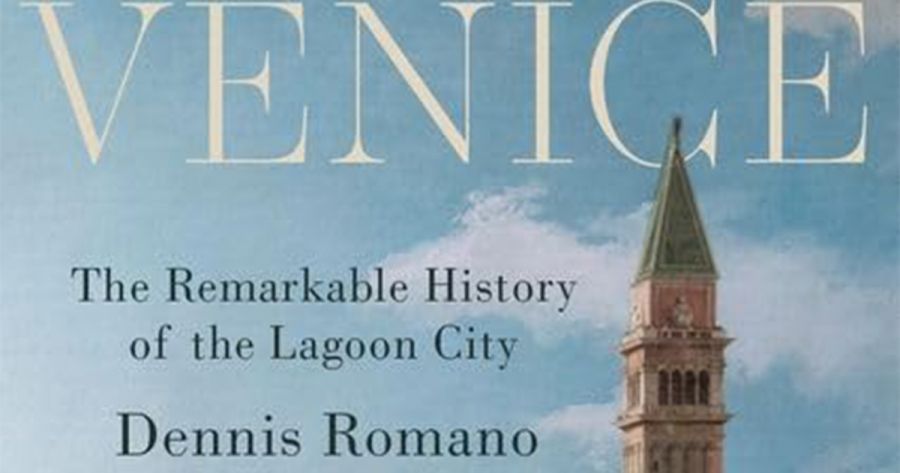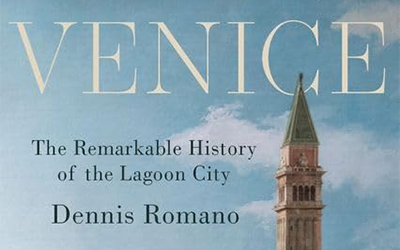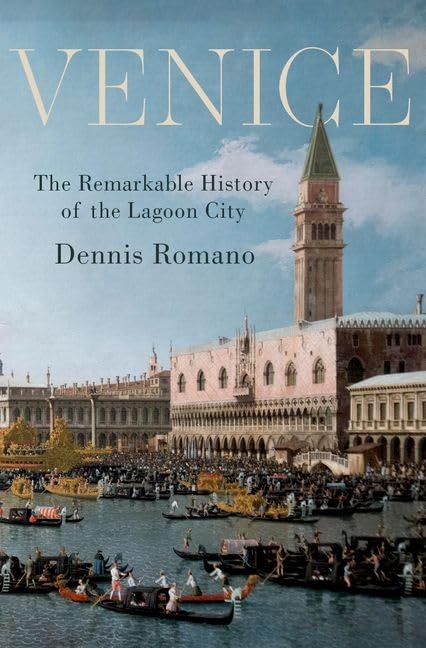
- Free Article: No
- Contents Category: History
- Review Article: Yes
- Article Title: What news on the Rialto?
- Article Subtitle: A revisionary history of Venice
- Online Only: No
- Custom Highlight Text:
Venice is a vast project for an historian. Dennis Romano has written what he calls a ‘remarkable history’, generous in its pursuit over 600 pages, with eighty-five pages of impeccable documentation. It is a revisionary history, not only because Romano goes beyond the end of the Republic in 1797, when Napoleon conquered Venice and planted a Tree of Liberty in St Mark’s Square. The three chapters on Modern and Contemporary Venice bring Romano’s history to the present day.
- Featured Image (400px * 250px):

- Alt Tag (Featured Image): Margaret Plant reviews ‘Venice: The remarkable history of the lagoon city’ by Dennis Romano
- Book 1 Title: Venice
- Book 1 Subtitle: The remarkable history of the lagoon city
- Book 1 Biblio: Oxford University Press, £31.99 hb, 791 pp
- Book 1 Cover Small (400 x 600):

- Book 1 Cover (800 x 1200):

- Book 1 Readings Link: https://www.readings.com.au/product/9780190859985/venice--dennis-romano--2024--9780190859985#rac:jokjjzr6ly9m
From its foundation in the sludge of the malaria-inducing lagoon, Venice was extraordinary, its refugee inhabitants hammering in wooden piles to support modest buildings in the mud, first in the outer lagoon at Torcello (still so atmospheric). The permanent site was at the Rialto, established as the centre of trade, and still a market. All building materials had to be brought in. Along what became the Grand Canal, the great palaces and warehouses were built. The sheer material effort was enormous, and its maintenance still is. In the ninth century, Venetian fishermen stole the relics of the Evangelist St Mark from Alexandria, and thereafter the symbol of the winged lion was to the forefront of the many Venetian ceremonies and processions. The golden Basilica of St Mark rises behind the giant flagpoles that still fly the lion alongside the Italian flag.
Venice became a major seafaring force in the Adriatic and the Mediterranean, establishing protected routes to Constantinople and the Levant, and consolidating territory. Salt was a primary industry from the beginning (the warehouses are still conspicuous), and ship-building and associated industries – sailmaking, oar-making, caulking (the great shell of the Arsenale is still in place, given over now to the often controversial Biennale d’Arte). Weaving wool, creating velvets and silks: such luxury textiles can still be seen in the Rubelli Showroom, and in the famous designs of Mariano Fortuny (who dressed Marcel Proust’s Albertine). Glass making, early established, remains one of Venice’s greatest projects. In the sixteenth century, Venice became the centre of printed books of unequalled elegance.
The longevity and concord of the Serenissima was remarkable, but Romano’s glasses are not rose-coloured. A noted social historian, he attends to the many ruptures and internal disturbances: discontent within the nobility, the patricians versus the people. He notes the many challenges from other city states: nearby Chioggia, Padua, Ferrara, Milan. Genoa was constantly challenging the Venetian hegemony of the seas. Later on, Venice confronted the formidable Ottoman and Habsburg empires.
In his ‘remarkable history’, Romano is at once a military, mercantile, and artisanal historian. He details manufacturing practices as well as Crusades and wars. The political structure with the Doge, the Great Council, and the numerous magistracies are present, of course, but so are the ordinary people in their parishes, the artisans and their guilds, and domestic servants. Romano is not primarily presenting a cultural history: the rooms of warships and torn banners in the Museo Correr and the Museo Storico Navale are as relevant as the Accademia art collection. Titian is only mentioned in passing. Rather, as Romano notes in his last pages, he wants to honour ‘the hundreds and thousands of the city’s inhabitants who did the truly hard work of forging the city’. He watches out for the women who made lace and threaded glass beads; at one point in Venice there were seventy-five female sailmakers.
There are shifts of emphasis in the passage through the centuries. Drawing close to 1797 when the Doge quietly stepped aside, Romano underlines positive changes and creativity. In the seventeenth century, he highlights the cultural vibrancy of a city most often seen as decadent and effete, given over to sex and libertinism. Yet it was a ‘transformative’ century and opera features in Romano’s account, not only for assignations in theatre boxes in the new La Fenice (1792), but in the political and social concerns in opera libretti. Carlo Goldoni renews Venetian theatre in comedies about ordinary people. In the eighteenth century, the murazzi were engineered from huge blocks of Istrian stone and positioned on the Lido to hold back the sea. This project was achieved with considerably more efficiency that the twentieth-century effort to design the Mose gates that can be lowered to block high seas at the mouths of the Lido.
There was no lack of leadership or incident in recent centuries as Venice joined united Italy after its subjugation by France and then Austria. Riccardo Selvatico established public housing projects and, in 1895, the Biennale d’Arte. In 1902, the Campanile in the Piazza collapsed and occasioned international debate as to whether it should be rebuilt as it was originally or in modern style. In the early twentieth century, the industrial magnate Giuseppe Volpi fostered tourism and established the industrial zone of Porto Marghera, a source of wealth and pollution.
Venice was a magnet for international visitors and personalities. Gabrielle d’Annunzio flew in and out during World War I, Luisa Casati walked her cheetahs in the Piazza San Marco, Mussolini appeared to crowds in the Piazza, and a Resistance movement operated in World War II. After the war, Peggy Guggenheim established her museum of contemporary art. In 1966, the great flood was among the most traumatic events in the history of Venice and the world registered the city’s peril. Flood and conflagration: La Fenice burnt down in 1996 and was slowly rebuilt as it was.
Well outnumbered by tourists, the local population is shrinking. In 2016, there were ‘shopping trolley’ protests against the cruise liners bringing crowds that overwhelmed the city centre. Carnival masks are made in China. We all know how precarious and how precious the city in the sea is. Perhaps it is too successful – ‘trapped by beauty’, in Romano’s words.


Comments powered by CComment